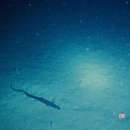en
names in breadcrumbs


The Notacanthiformes /nɒtəˈkænθɪfɔːrmiːz/ are an order of deep-sea ray-finned fishes, consisting of the families Halosauridae and Notacanthidae (spiny eels).[1]
The order is of relatively recent vintage; Fishes of the World (2006) lists it as the suborder Notacanthoidei of Albuliformes.[2] The notacanthiforms are much more eel-like than the albuliforms; for instance, the caudal fin has disappeared.
Fish of the order are found in oceans worldwide, at depths from 120 to 4,900 metres (390 to 16,080 ft). They are elongated fish, although not as much so as the true eels. They typically feed on slow-moving or sessile animals, such as molluscs, echinoderms, and sea anemones. Like the true eels, they have a leptocephalus larva that floats in the surface waters before transforming into an adult. Unusually, the larva can often be larger than the adult.[3]
The Notacanthiformes /nɒtəˈkænθɪfɔːrmiːz/ are an order of deep-sea ray-finned fishes, consisting of the families Halosauridae and Notacanthidae (spiny eels).
The order is of relatively recent vintage; Fishes of the World (2006) lists it as the suborder Notacanthoidei of Albuliformes. The notacanthiforms are much more eel-like than the albuliforms; for instance, the caudal fin has disappeared.
Fish of the order are found in oceans worldwide, at depths from 120 to 4,900 metres (390 to 16,080 ft). They are elongated fish, although not as much so as the true eels. They typically feed on slow-moving or sessile animals, such as molluscs, echinoderms, and sea anemones. Like the true eels, they have a leptocephalus larva that floats in the surface waters before transforming into an adult. Unusually, the larva can often be larger than the adult.